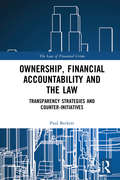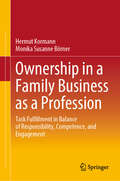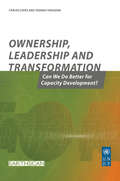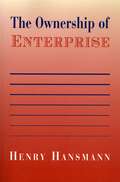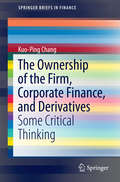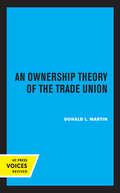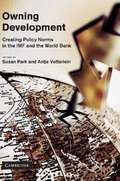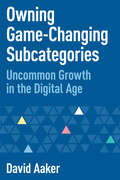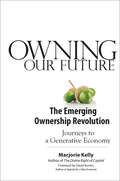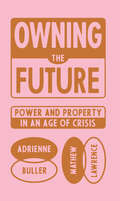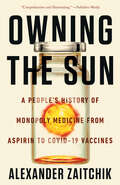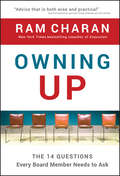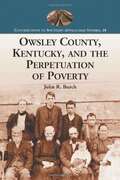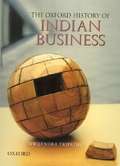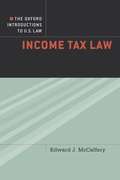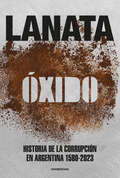- Table View
- List View
Ownership, Financial Accountability and the Law: Transparency Strategies and Counter-Initiatives (The Law of Financial Crime)
by Paul BeckettThere is something visceral about ownership. This is mine; you can’t have it. This is mine; you can share it. This is ours. Try to find it. Contemporary literature and investigative journalism are showing that the scale of the problem of tax evasion, money laundering, organised crime, terrorism, bribery, corruption and gross human rights abuses is vast. Ownership – specifically, the quest to identify beneficial owners - has been chosen by national and international regulators as the touchstone, the litmus test in the fight back. An owner by definition must possess something for which they are financially accountable. But what is meant by "ownership"? This book explains why ownership is pivotal to accountability, and what ownership means in common law, civil law and Shariah law terms. It looks in detail at State, regional and international transparency strategies and at an equally powerful global private counter-initiative to promote beneficial ownership avoidance through the use of so-called "orphan structures". Where there is no owner, there is no accountability. The distinction between privacy and legitimate confidentiality on the one hand, and concealment on the other is explained with reference to commercial and trade law and practice, principles of corporate governance and applicable business human rights. This book introduces one further counter initiative: the phenomenon of transient ownership made possible through the use of cryptocurrency and the blockchain. The study concludes with a blueprint for action with recommendations addressed to states, international organisations, practitioners and other stakeholders.
Ownership in a Family Business as a Profession: Task Fulfillment in Balance of Responsibility, Competence, and Engagement
by Hermut Kormann Monika Susanne BörnerThis book is aimed at owners, especially non-operating shareholders of family businesses. They work behind the scenes and carry significant responsibility for the success of the company. What characterizes good ownership? What competencies are essential for fulfilling their duties? How can succeeding shareholders also find guidance in the complex field of family businesses? Knowledgeable and practical, the authors outline all relevant areas of action. The book provides encouragement and support for developing a professional ownership structure and task distribution tailored to the individual situation and constellation of one's own family business.
Ownership Leadership and Transformation: Can We Do Better for Capacity Development
by Thomas Theisohn Carlos LopesThe third and final in a series, this text bridges the conceptual foundations of capacity development and the difficulties and practical realities in the field. It demystifies the process of capacity development to make it more user-friendly. The book has two parts. The first shows how long-standing development dilemmas can be turned into opportunities for capacity development and societal transformation. It proposes a set of principles to guide the search for context-specific approaches as the norm, and based on these default principles the authors explore relevant issues in comprehensible stages through a capacity lens. The second part is a compilation of experiences and lessons from around the world, to showcase promising initiatives and innovative solutions. It forms a casebook of insights and good (rather than best) practices on how development stakeholders can turn development dilemmas into opportunities tailored to the needs of their societies.
The Ownership of Enterprise
by Henry HansmannThe investor-owned corporation is the conventional form for structuring large-scale enterprise in market economies. But it is not the only one. Even in the United States, noncapitalist firms play a vital role in many sectors. Employee-owned firms have long been prominent in the service professions--law, accounting, investment banking, medicine--and are becoming increasingly important in other industries. The buyout of United Airlines by its employees is the most conspicuous recent instance. Farmer-owned produce cooperatives dominate the market for most basic agricultural commodities. Consumer-owned utilities provide electricity to one out of eight households. Key firms such as MasterCard, Associated Press, and Ace Hardware are service and supply cooperatives owned by local businesses. Occupant-owned condominiums and cooperatives are rapidly displacing investor-owned rental housing. Mutual companies owned by their policyholders sell half of all life insurance and one-quarter of all property and liability insurance. And nonprofit firms, which have no owners at all, account for 90 percent of all nongovernmental schools and colleges, two-thirds of all hospitals, half of all day-care centers, and one-quarter of all nursing homes. Henry Hansmann explores the reasons for this diverse pattern of ownership. He explains why different industries and different national economies exhibit different distributions of ownership forms. The key to the success of a particular form, he shows, depends on the balance between the costs of contracting in the market and the costs of ownership. And he examines how this balance is affected by history and by the legal and regulatory framework within which firms are organized.
The Ownership of Enterprise
by Henry HansmannThe investor-owned corporation is the conventional form for structuring large-scale enterprise in market economies. But it is not the only one. Even in the United States, noncapitalist firms play a vital role in many sectors. Employee-owned firms have long been prominent in the service professions--law, accounting, investment banking, medicine--and are becoming increasingly important in other industries. The buyout of United Airlines by its employees is the most conspicuous recent instance. Farmer-owned produce cooperatives dominate the market for most basic agricultural commodities. Consumer-owned utilities provide electricity to one out of eight households. Key firms such as MasterCard, Associated Press, and Ace Hardware are service and supply cooperatives owned by local businesses. Occupant-owned condominiums and cooperatives are rapidly displacing investor-owned rental housing. Mutual companies owned by their policyholders sell half of all life insurance and one-quarter of all property and liability insurance. And nonprofit firms, which have no owners at all, account for 90 percent of all nongovernmental schools and colleges, two-thirds of all hospitals, half of all day-care centers, and one-quarter of all nursing homes. Henry Hansmann explores the reasons for this diverse pattern of ownership. He explains why different industries and different national economies exhibit different distributions of ownership forms. The key to the success of a particular form, he shows, depends on the balance between the costs of contracting in the market and the costs of ownership. And he examines how this balance is affected by history and by the legal and regulatory framework within which firms are organized. With noncapitalist firms now playing an expanding role in the former socialist countries of Eastern Europe and Asia as well as in the developed market economies of the West, The Ownership of Enterprise will be an important book for business people, policymakers, and scholars.
The Ownership of the Firm, Corporate Finance, and Derivatives
by Kuo-Ping ChangThis book clarifies several ambiguous arguments and claims in finance and the theory of the firm. It also serves as a bridge between derivatives, corporate finance and the theory of the firm. In addition to mathematical derivations and theories, the book also uses anecdotes and numerical examples to explain some unconventional concepts. The main arguments of the book are: (1) the ownership of the firm is not a valid concept, and firms' objectives are determined by entrepreneurs who can innovate to earn excess profits; (2) the Modigliani-Miller capital structure irrelevancy proposition is a restatement of the Coase theorem, and changes in the firm's debt-equity ratio will not affect equity-holders' wealth (welfare), and equity-holders' preferences toward risk (or variance) are irrelevant; (3) all firms' resources are options, and every asset is both a European call and a put option for any other asset; and (4) that a first or residual claim between debt and equity is non-existent while the first claim among fixed-income assets can actually affect the market values of these assets.
Ownership Structure in Professional Service Firms: Partnership vs. Public Corporation
by Ashish Nanda Lauren PrusinerIndustry and Background Note
An Ownership Theory of the Trade Union
by Donald L. MartinThis title is part of UC Press's Voices Revived program, which commemorates University of California Press’s mission to seek out and cultivate the brightest minds and give them voice, reach, and impact. Drawing on a backlist dating to 1893, Voices Revived makes high-quality, peer-reviewed scholarship accessible once again using print-on-demand technology. This title was originally published in 1980.
Ownership Unbundling and Related Measures in the EU Energy Sector: Foundations, The Impact Of Wto Law And Investment Protection (European Yearbook of International Economic Law #5)
by Tilman Michael DralleThis book provides the first comprehensive analysis of unbundling and, in particular, ownership unbundling policies from the perspective of international economic law. It does so by focusing on the prominent example of the EU’s energy sector and its Third Energy Package. Unbundling has become an increasingly crucial competition instrument in network-bound industries worldwide. It is designed to ensure access to bottleneck infrastructures on fair and non-discriminatory terms and thus to suppress the anti-competitive potential deriving from vertical integration in natural monopoly situations. While promoting important public policy objectives, unbundling policies have also raised a number of legal issues. This book analyzes how international economic law limits the adoption and maintenance of unbundling and related measures and also outlines how international trade law can play a ‘positive’ role in this field. As a result, it provides a valuable reference for academics, practitioners and policy-makers.
Owning Development: Creating Policy Norms in the IMF and the World Bank
by Susan Park Antje VetterleinAs pillars of the post-1945 international economic system, the International Monetary Fund (IMF) and the World Bank are central to global economic policy debates. This book examines policy change at the IMF and the World Bank, providing a constructivist account of how and why they take up ideas and translate them into policy, creating what we call 'policy norms'. The authors compare processes of policy emergence and change and, using archival and interview data, analyse nine policy areas including gender, debt relief, and tax and pension reform. Each chapter traces the policy norm process in order to shed light on the main sources and mechanisms for norm change within international organisations. Owning Development details the strength of these policy norms which emerge, then either stabilise or decline. The book establishes valuable insights into the strength of current development policies propounded by international organisations and the possibility for change.
Owning Game-Changing Subcategories: Uncommon Growth in the Digital Age
by David AakerOwning Game-Changing Subcategories is about creating organizational growth in the digital age by creating and owning game-changing subcategories fueled by digital.Owning Game-Changing Subcategories outlines the path to finding, managing, and leveraging new subcategories. In the digital age, the path has been made wider, shorter, and more frequently traveled. Throughout Owning Game-Changing Subcategories, David Aaker discusses certain aspects of the digital age that alter this path, such as E-commerce providing fast, inexpensive market access bypassing the cost of gaining distribution into storefront retailers or creating personal sales teams and social media and websites enabling communication on steroids in comparison with traditional use of advertising or events. Growth is not only a success measure but also creates energy and opportunity for customers and employees. And such growth almost never occurs with “my brand is better than your brand” marketing. Owning Game-Changing Subcategories explores the only ways to grow a business (with rare exceptions) which is to:develop new “must haves” that define a game-changing subcategory that provides a new or markedly superior buying or use experience or brand relationship to a core customer base;become the exemplar brand that represents the subcategory and drives its visibility, positioning, and success; and create barriers to competitors that could include “must-have” associations and a basis of relationships that go beyond functional benefits.
Owning Our Future: The Emerging Ownership Revolution
by Marjorie KellyA collection of company profiles that &“succeeds in demonstrating how more sustainable business ventures can function in practice&” (Publishers Weekly). As long as businesses are set up to focus exclusively on maximizing financial income for the few, our economy will be locked into endless growth and widening inequality. But now people are experimenting with new forms of ownership, which Marjorie Kelly calls generative: aimed at creating the conditions for life for many generations to come. These designs may hold the key to the deep transformation our civilization needs. To understand these emerging alternatives, Kelly reports from all over the world, visiting a community-owned wind facility in Massachusetts, a lobster cooperative in Maine, a multibillion-dollar employee-owned department-store chain in London, a foundation-owned pharmaceutical company in Denmark, a farmer-owned dairy in Wisconsin, and other places where a hopeful new economy is being built. Along the way, she finds the five essential patterns of ownership design that make these models work. &“This magnificent book is a kind of recipe for how civilization might cope with its too-big-to-fail problem. It&’s a hardheaded, clear-eyed, and therefore completely moving account of what a different world might look like—what it already does look like in enough places that you will emerge from its pages inspired to get involved.&” —Bill McKibben, author of Deep Economy
Owning the Future: Power and Property in an Age of Crisis
by Mathew Lawrence Adrienne BullerA radical manifesto for the transformation of post-pandemic politicsThe question of ownership is the critical fault line of our times. During the pandemic this issue has only become more divisive. Since March 2020 we have witnessed the extraordinary growth of asset manager capitalism and the explosive concentration of wealth within the hands of the already super-rich. This new oligarchy controls every part of our social and economics lives.In the face of crisis, the authors warn that mere redistribution within current forms of ownership is not enough; our goal must be to go beyond the limits of the current system, dominated by private enclosure and unequal ownership. Only by reimagining how our economy is owned and by whom can we address the crises of our time - from the fallout of the pandemic to ecological collapse - at their roots.Building from this insight, the authors argue the systemic change we need hinges on a new era of democratic ownership: a reinvention of the firm as a vehicle for collective endeavour and meeting social needs. Against the new oligarchy of the platform giants, a digital commons that uses our data for collective good, not private profit. In place of environmental devastation, a new agenda of decommodification - of both nature and needs - with a Green New Deal and collective stewardship of the planet&’s natural wealth. Together, these proposals offer a road map to owning the future, and building a better world.
Owning the Sun: A People's History of Monopoly Medicine from Aspirin to COVID-19 Vaccines
by Alexander ZaitchikFor readers of Bad Blood and Empire of Pain, an authoritative look at monopoly medicine from the dawn of patents through the race for COVID-19 vaccines and how the privatization of public science has prioritized profits over peopleOwning the Sun tells the story of one of the most contentious fights in human history: the legal right to produce lifesaving medicines. Medical science began as a discipline geared toward the betterment of all human life, but the merging of research with intellectual property and the rise of the pharmaceutical industry warped and eventually undermined its ethical foundations. Since World War II, federally funded research has facilitated most major medical breakthroughs, yet these drugs are often wholly controlled by price-gouging corporations with growing international ambitions. Why does the U.S. government fund the development of medical science in the name of the public only to relinquish exclusive rights to drug companies, and how does such a system impoverish us, weaken our responses to crises, and, as in the cases of AIDS and COVID-19, put the world at risk? Outlining how generations of public health and science advocates have attempted to hold the line against Big Pharma and their allies in government, Alexander Zaitchik&’s first-of-its-kind history documents the rise of privatized medicine in the United States and its subsequent globalization. From the controversial arrival of patent-wielding German drug firms in the late nineteenth century to present-day coordination between industry and philanthropic organizations—including the influential Bill & Melinda Gates Foundation—that stymie international efforts to vaccinate the world against COVID-19, Owning the Sun tells one of the most important and least understood histories of our time.
Owning Up
by Ram Charan"This book is a most important contribution for both new and experienced directors, addressing contemporary corporate governance. The 14 practical questions represent the most vital issues that boards need to proactively address and are particularly crucial now as boards deal with the aftermath of the global financial tsunami. " -Thomas J. Neff, chairman, U. S. , Spencer Stuart "If Corporate America's board members had answered these questions, the crisis of '08 would have been avoided. The book is that powerful. It should be required reading in every boardroom, executive suite, and business school on the planet. This book with its singular wisdom could change the face of corporate governance-with huge dividends to shareholders and society. " -Ralph Whitworth, principal, Relational Investors LLC "Ram Charan always seems to get it right. Owning Up not only asks the right questions, it gives answers that can make a real difference for improving board performance. " -James M. Kilts, former chairman and CEO, The Gillette Company "As always, well-reasoned, insightful, and thought-provoking. A work that every director will find of value, particularly given the intense pressure of these unprecedented economic times. " -Professor Charles M. Elson, director of the John L. Weinberg Center for Corporate Governance at the University of Delaware "Here is the book that every corporate director needs today. With his decades of insider experience, Ram Charan brings more wisdom and insight to this subject than anyone else I know. " -Geoff Colvin, Fortune editor and author, Talent Is Overrated: What Really Separates World-Class Performers from Everybody Else
Owsley County, Kentucky, And The Perpetuation Of Poverty (Contributions To Southern Appalachian Studies #18)
by John R. BurchOwsley County, Kentucky, is well known by journalists, academics, and local historians as a quintessential example of rural poverty in Appalachia. This study identifies several reasons behind Owsley County's ongoing struggle with poverty, including the county's lack of natural resources, a poor transportation system, and a centralized socio-political power structure controlled by the entrenched elite. The author asserts that Owsley County's economic hardships are far from unique, but rather are representative of a significant number of Appalachian counties and towns. Several tables and appendices provide useful demographic, legislative, and agricultural data.
The Oxford History of Indian Business
by Dwijendra TripathiThis book provides an understanding of the roots of modern business practices in India. It is an authoritative history of Indian business in the period that charts the course of the transition of business from mercantile to industrial capitalism.
The Oxford Introductions to U. S. Law: Income Tax Law
by Edward J. MccafferyIn The Oxford Introductions to U. S. Law: Income Tax Law, Edward McCaffery presents an accessible introduction to the major topics in the field of federal income taxation, such as income, deductions, and recognition of gains and losses. After discussing central rules and doctrines individually,Edward McCaffery offers a very sophisticated yet clear explanation of the interplay among them, carefully describing how they work together to carry out the policy goals of the U. S. tax system. Professor McCaffery describes, for example, how the current income tax in the United States has increasingly become a wage tax that favors those with capital rather than those whose money comes from labor. In explaining the consequences of tax policy on individuals, he also considers important possible alternatives for income taxation in the U. S. The Oxford Introductions to U. S. Law: Income Tax Law sets forth the 'who,' 'what,' 'when,' and 'why' of income tax law and describes the essential concepts of the field in a clear and concise manner that helps students and non-experts increase their understanding of the policies behind modern tax aw and the ways in which these policies affect different types of individuals.
Óxido: Historia de la corrupción en Argentina 1580-2023
by Jorge LanataUna investigación integral, histórica y periodística de la corrupción argentina a través de cinco siglos: del Virreinato al Olivosgate, Jorge Lanata recorre este proceso imparable de descomposición nacional y lo ilumina a través de una selección sorprendente de casos tanto poco conocidos como notables. Argentina está oxidada. La corrupción es su óxido. Y se extiende cada vez más sobre el país. Creemos verlo, creemos que está a la vista de todos. Pero, según los últimos estudios, solo el 12% de los hechos de corrupción conocidos llegan a la Justicia y solo el 2% recibe algún tipo de condena. Con el correr de los años, la corrupción ha ido cambiando, expandiéndose, perfeccionándose, poniéndose al abrigo de la impunidad. Aunque algo se mantuvo invariable: el rol del Estado. El inventor de la barrera siempre cobró peaje. En esta investigación histórica y periodística, Jorge Lanata recorre este proceso imparable de descomposición nacional y lo ilumina a través de una selección sorprendente de casos tanto poco conocidos como notables, que arrancan cuando Argentina no era todavía una república y llegan hasta hoy, cuando se pregunta si puede volver a serlo. Una radiografía descarnada para contar un país que -de forma deliberada, por omisión o negligencia- ha construido un sistema funcional al fraude, la malversación, la usurpación, el tráfico de influencias y el robo liso y llano. Un sistema en el que es casi imposible investigar y cuando se investiga, no se sanciona. En el que nunca hay funcionarios inocentes ni culpables, sino tan solo sospechosos. Una herrumbre que nos corroe desde siempre y se expande frente a nuestros ojos.
OXO International
by H. Kent Bowen Marilyn E. Matis Sylvie RyckebuschOXO, a kitchen tools and gadgets company, was started by a businessman who had 30 years of experience in the housewares industry. With his wife and son as founders, he creates a new niche in the gadgets industry for high-end gourmet stores. The company has headquarters in New York City, but it outsources product design to a NYC industrial design firm, manufacturing to Asia, and warehousing to a site in Connecticut in order to manage start-up costs and growth. Because of the veteran businessman's reputation and industry sense, the company grows quickly and in 1992 is sold for $6.2 million to a large housewares distributor, General Housewares. The original owners stay on as consultants to the parent company and decide to turn over management of the company to a Harvard MBA who also has extensive industrial design experience. Innovative product design is the key to OXO's success, and the company has worked exclusively with one design firm based on royalties of sold products. The new managing director initiates new product category programs for the bathroom, the garden, and home baking. He must coordinate the outsourcing of the design and development function.
OXXO's Turf War Against Extra (A)
by Annelena Lobb Gerardo Perez Cavazos Tatiana SandinoIn 2006, Mexican convenience store chain OXXO faced a threat from a formidable competitor, the rival convenience chain Extra. OXXO had embarked on an initiative to fortify its corporate culture and operating system, but the threat of Extra raised the question of whether they should focus on opening as many stores as possible and as quickly as possible, in order to maintain market leadership. CEO Eduardo Padilla had to define his strategy and decide whether to focus on improving culture and operations or on relentlessly beating its rival.
OXXO's Turf War Against Extra (A)
by Annelena Lobb Tatiana Sandino Gerardo Perez CavazosIn 2006, Mexican convenience store chain OXXO faced a threat from a formidable competitor, the rival convenience chain Extra. OXXO had embarked on an initiative to fortify its corporate culture and operating system, but the threat of Extra raised the question of whether they should focus on opening as many stores as possible and as quickly as possible, in order to maintain market leadership. CEO Eduardo Padilla had to define his strategy and decide whether to focus on improving culture and operations or on relentlessly beating its rival.
OXXO's Turf War Against Extra (B)
by Annelena Lobb Gerardo Perez Cavazos Tatiana SandinoIn 2006, Mexican convenience store chain OXXO faced a threat from a formidable competitor, the rival convenience chain Extra. OXXO had embarked on an initiative to fortify its corporate culture and operating system, but the threat of Extra raised the question of whether they should focus on opening as many stores as possible and as quickly as possible, in order to maintain market leadership. CEO Eduardo Padilla had to define his strategy and decide whether to focus on improving culture and operations or on relentlessly beating its rival.
OXXO's Turf War Against Extra (B)
by Annelena Lobb Tatiana Sandino Gerardo Perez CavazosIn 2006, Mexican convenience store chain OXXO faced a threat from a formidable competitor, the rival convenience chain Extra. OXXO had embarked on an initiative to fortify its corporate culture and operating system, but the threat of Extra raised the question of whether they should focus on opening as many stores as possible and as quickly as possible, in order to maintain market leadership. CEO Eduardo Padilla had to define his strategy and decide whether to focus on improving culture and operations or on relentlessly beating its rival.
OYO: Creating Effective Spaces
by Das Narayandas Sunil Gupta Rachna Tahilyani Mahima Rao-Kachroo"In August 2017, Ritesh Agarwal, CEO and founder of Gurugram-baseda OYO, an online, curated, hotel room marketplace that provided reliable and quality budget rooms, announced the launch of OYO Asset Management (OAM). OAM was the brand for the services that OYO provided property owners looking to transform their under-utilized properties such as hotels, houses and corporate spaces, into modern, fully-furnished hotels.1"
